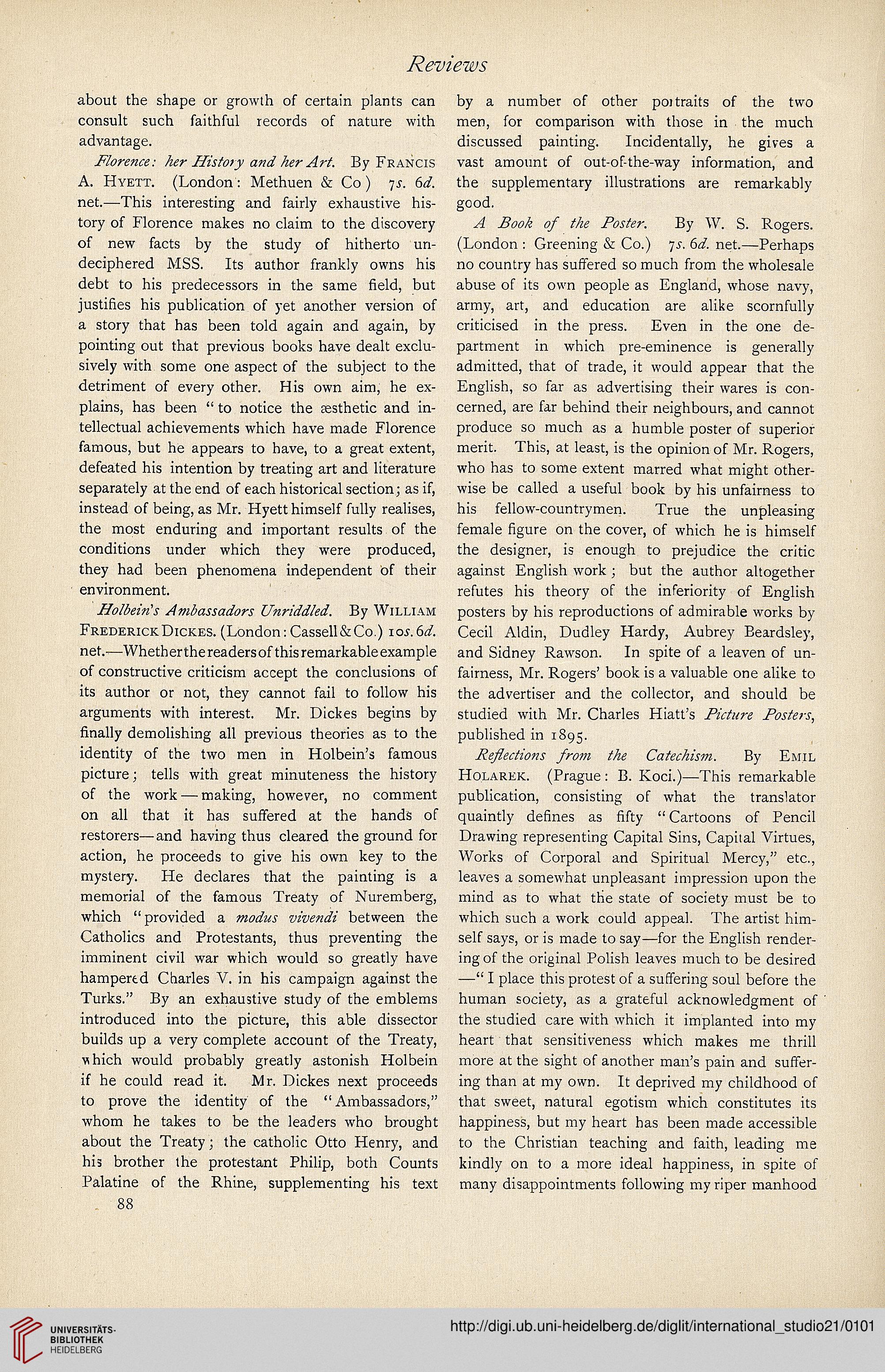about the shape or growth of certain plants can
consult such faithful records of nature with
advantage.
By FRANCis
A. HvETT. (London: Methuen & Co) 7J. 6A.
net.—This interesting and fairly exhaustive his-
tory of Florence makes no claim to the discovery
of new facts by the study of hitherto un-
deciphered MSS. Its author frankly owns his
debt to his predecessors in the same field, but
justifres his publication of yet another Version of
a story that has been told again and again, by
pointing out that previous books have dealt exclu-
sively with some one aspect of the subject to the
detriment of every other. His own aim, he ex-
plains, has been " to notice the Eesthetic and in-
tellectual achievements which have made Florence
famous, but he appears to have, to a great extent,
defeated his intention by treating art and literature
separately at the end of each historical section; as if,
instead of being, as Mr. Hyett himself fully realises,
the most enduring and important results of the
conditions under which they were produced,
they had been phenomena independent of their
environment.
C/hHAZAA. By WtLUAM
FREDERicKDicuES. (London: Cassell&Co.) ior.6A
net.—Whether the readers of this remarkable example
of constructive criticism accept the conclusions of
its author or not, they cannot fail to follow his
arguments with interest. Mr. Dickes begins by
trnally demolishing all previous theories as to the
identity of the two men in Holbein's famous
picture; teils with great minuteness the history
of the work — making, however, no comment
on all that it has suffered at the hands of
restorers—and having thus cleared the ground for
action, he proceeds to give his own key to the
mystery. He declares that the painting is a
memorial of the famous Treaty of Nuremberg,
which "provided a between the
Catholics and Protestants, thus preventing the
imminent civil war which would so greatly have
hampertd Charles V. in his campaign against the
Turks." By an exhaustive study of the emblems
introduced into the picture, this able dissector
builds up a very complete account of the Treaty,
v hich would probably greatly astonish Holbein
if he could read it. Mr. Dickes next proceeds
to prove the identity of the "Ambassadors,"
whom he takes to be the leaders who brought
about the Treaty; the catholic Otto Henry, and
his brother the Protestant Philip, both Counts
Palatine of the Rhine, supplementing his text
88
by a number of other pottraits of the two
men, for comparison with those in the much
discussed painting. Incidentally, he gives a
vast amount of out-of-the-way information, and
the supplementary illustrations are remarkably
good.
^4 AbyAa*. By W. S. Rogers.
(London : Greening & Co.) yj'. 6A. net.—Perhaps
no country has suffered so much from the Wholesale
abuse of its own people as England, whose navy,
army, art, and education are alike scornfully
criticised in the press. Even in the one de-
partment in which pre-eminence is generally
admitted, that of trade, it would appear that the
English, so far as advertising their wares is con-
cerned, are far behind their neighbours, and cannot
produce so much as a humble poster of superior
merit. This, at least, is the opinion of Mr. Rogers,
who has to some extent marred what might other-
wise be called a useful book by his Unfairness to
his fellow-countrymen. True the unpleasing
female Hgure on the cover, of which he is himself
the designer, is enough to prejudice the critic
against English work ; but the author altogether
refutes his theory of the inferiority of English
posters by his reproductions of admirable works by
Cecil Aldin, Dudley Hardy, Aubrey Beardsley,
and Sidney Rawson. In spite of a leaven of Un-
fairness, Mr. Rogers' book is a valuable one alike to
the advertiser and the collector, and should be
studied with Mr. Charles Hiatt's AhjA/r,
published in 189g.
By EMIL
HoLAREK. (Prague : B. Koci.)—This remarkable
publication, consisting of what the translator
quaintly defines as fifty " Cartoons of Pencil
Drawing representing Capital Sins, Capital Virtues,
Works of Corpora! and Spiritual Mercy," etc.,
leaves a somewhat unpleasant impression upon the
mind as to what the state of society must be to
which such a work could appeal. The artist him-
self says, or is made to say—for the English render-
ing of the original Polish leaves much to be desired
—" I place this protest of a suffering soul before the
human society, as a grateful acknowledgment of
the studied care with which it implanted into my
heart that sensitiveness which makes me thrill
more at the sight of another man's pain and suffer-
ing than at my own. It deprived my childhood of
that sweet, natural egotism which constitutes its
happiness, but my heart has been made accessible
to the Christian teaching and faith, leading me
kindly on to a more ideal happiness, in spite of
rnany disappointments following my riper manhood




